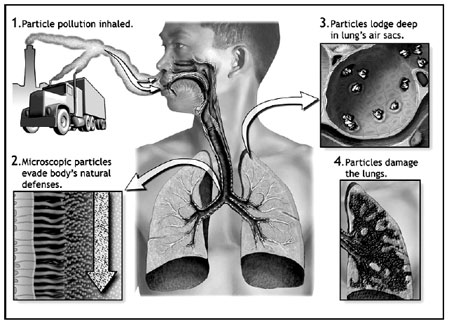How to reduce your exposure to diesel exhaust pollution and protect your health
Diesel exhaust is dangerous to your health. It contains tiny carbon particles, each coated with 30 or more toxins. Small particles can enter your bloodstream through your lungs, and carry toxins to organs throughout your body. The smallest particles can enter your brain.

Photo credit: Laura Marschke, Southwest Early College
The World Health Organization has declared that diesel exhaust causes cancer, and hundreds of scientific studies have linked it to numerous health problems in children, including attention deficit hyperactivity disorder (ADHD), anxiety and depression, autism and autism spectrum disorder, birth defects, brain cancer, impulsivity and emotional problems, insulin resistance & diabetes, leukemia, low birth weight, lupus, lung damage and other respiratory problems, mental illness, obesity, preterm birth, and reduced intelligence.
Diesel exhaust has also been linked to anxiety, asthma, atherosclerosis (hardening of the arteries), Alzheimer’s and Parkinson’s diseases, cognitive decline, reduction in brain volume, congestive heart failure, atrial fibrillation, dementia, cardiovascular diseases, and strokes, high blood pressure, premature death, respiratory disease, and suicide.
The people most at risk of diesel exhaust related illnesses are the more than 45 million people who live or work near ports, rail yards, or distribution centers, or within 150 meters of a major highway. A disproportionate percentage of that population are low-income and/or members of minority groups.
The EPA recently agreed to the #ZeroEmissionsNow campaign request by the Moving Forward Network and colleagues that they form an interagency team to figure out how to reduce the amount of diesel exhaust pollution these millions of people are exposed to, but that will not happen overnight.
Until the government takes action to reduce these health risks, you should take whatever actions you can to protect yourself and your family! There is a lot you can do, summarized below, with links for more information:
-
Pay attention to your city’s local Air Quality Index, which will let you know when your city’s air is dangerous and you should avoid outdoor activities. Learn more about this here. But be aware that the air in neighborhoods near pollution sources can be unhealthy even when air in the rest of the city is safe.
-
Always avoid exercising near high traffic areas or other highly polluted areas. Get more information on that from the American Lung Association.
-
Whether you bike, drive, walk, or take public transit to work or play, try to avoid heavy highway or rail freight routes. Research shows that bicyclists can reduce their exposure by 20-30 percent by choosing less polluted routes. Get more details from Colorado State University.
-
Don’t drive a diesel powered vehicle if you can avoid it – especially an old or poorly maintained vehicle.
-
If you can, avoid living near freight routes, warehouse districts, ports, or rail yards.
-
If you must live in an area with unhealthy levels of air pollution, keep your indoor air clean, buy or build a HEPA filter, and close up your house when air pollution is the most dangerous. Check out this video to learn how to build one for about $25.
-
If you must be outside when particulate matter levels are unhealthy, consider wearing a surgical mask, especially if you are a member of a sensitive group. The New York Times has good information on how to choose one.
-
If you find yourself in your car in traffic with unsafe levels of air pollution, close your windows, and turn off your fan or outside air source. The latest research on the effectiveness of this approach is here.
Do you have other ideas on how to protect yourself? Please share them in comments here!

